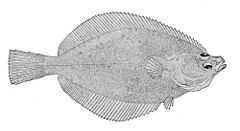Longhead dab
From Wikipedia, the free encyclopedia
| Longhead dab | |
|---|---|
 | |
| Conservation status | |
| Not evaluated | |
| Scientific classification | |
| Kingdom: | Animalia |
| Phylum: | Chordata |
| Class: | Actinopterygii |
| Order: | Pleuronectiformes |
| Family: | Pleuronectidae |
| Genus: | Limanda |
| Species: | L. proboscidea |
| Binomial name | |
| Limanda proboscidea C. H. Gilbert, 1896 | |
The longhead dab, Limanda proboscidea, is a flatfish of the family Pleuronectidae. It is a demersal fish that lives on bottoms at depths of up to 160 metres (520 ft), though it is most commonly found between 10 and 125 metres (33 and 410 ft). Its native habitat is the temperate waters of the northern Pacific, and it range stretches from the Sea of Okhotsk and the Kuril Islands to the Bering Sea and the arctic west coast of Canada. Males grow up to 40 centimetres (16 in) in length, though the common length is around 17.5 centimetres (6.9 in).[1]
Diet
The diet of the longhead dab consists mainly of zoobenthos organisms, including polychaetes, bivalves, amphipods and other benthos crustaceans.[1]
References
- ↑ 1.0 1.1 "Limanda aspera". Fishbase. 6 October 2010. Retrieved 2011-07-26.
|coauthors=requires|author=(help)
This article is issued from Wikipedia. The text is available under the Creative Commons Attribution/Share Alike; additional terms may apply for the media files.